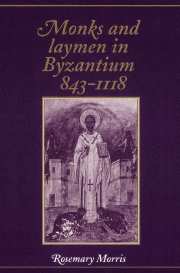Book contents
- Frontmatter
- Contents
- List of maps
- List of tables
- Acknowledgements
- Note on transliteration and citation
- List of abbreviations
- Introduction
- PART I FOUNDERS AND BENEFACTORS
- 1 The resurgence of the monastic life
- 2 Groups, communities and solitaries
- 3 Monastic founders
- 4 Monasticism and society
- 5 Piety, patronage and politics
- PART II PROTECTION AND SURVIVAL
- Appendix: Imperial privileges to monasteries, c. 900–1118
- Bibliography
- Index
1 - The resurgence of the monastic life
from PART I - FOUNDERS AND BENEFACTORS
Published online by Cambridge University Press: 10 December 2009
- Frontmatter
- Contents
- List of maps
- List of tables
- Acknowledgements
- Note on transliteration and citation
- List of abbreviations
- Introduction
- PART I FOUNDERS AND BENEFACTORS
- 1 The resurgence of the monastic life
- 2 Groups, communities and solitaries
- 3 Monastic founders
- 4 Monasticism and society
- 5 Piety, patronage and politics
- PART II PROTECTION AND SURVIVAL
- Appendix: Imperial privileges to monasteries, c. 900–1118
- Bibliography
- Index
Summary
We have had, we have indeed had our winter – and what a winter! … But see that spring has burst into bloom, promising divine favours and finds us all assembled to offer a prayer of thanksgiving in return for a happy harvest!
The enthronement of the new patriarch Methodios of Constantinople on 11 March 843 marked the beginning of a new era in the Byzantine church. For the triumph of the iconodules, those who supported the veneration of religious images was now, finally, achieved and this practice was re-established as a crucial element in orthodox worship. The Feast of Orthodoxy, which came to be celebrated on that day (the first Sunday in Lent) with processions and celebrations, brought together the forces which were deemed to have conquered iconoclasm: the imperial family, which, in the person of the Empress Theodora acting for her young son, Michael III, had finally cast aside error; the orthodox clergy who had stayed faithful through the long years of persecution and, last, but certainly not least, the monks from Constantinople and beyond, who had provided the most stubborn and steadfast opposition to the iconoclasts in the previous two centuries.
This, at least, was the picture familiar to pious Byzantines by the end of the ninth century. By this time, the iconoclast clergy had been purged; iconoclast writings and conciliar decrees had been systematically destroyed and a programme of figural redecoration of the most important churches of the empire had begun.
- Type
- Chapter
- Information
- Monks and Laymen in Byzantium, 843–1118 , pp. 9 - 30Publisher: Cambridge University PressPrint publication year: 1995
- 1
- Cited by



